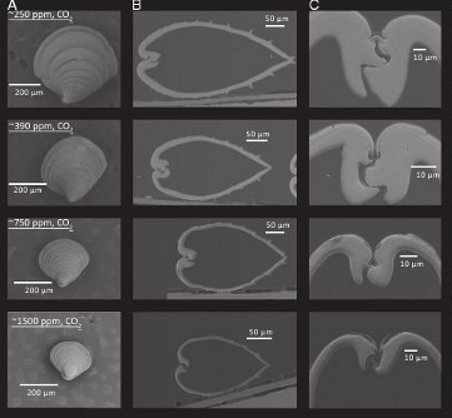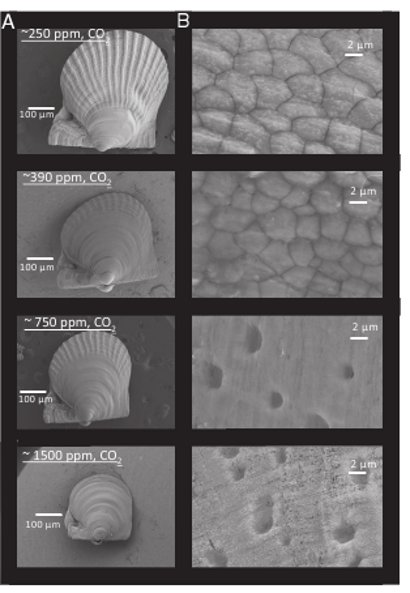
Through the burning of fossil fuels, humans are rapidly altering the chemistry of the global oceans, making seawater increasingly more acidic. Most attention to date has focused on what we might expect in the years to come, and rightly so, many studies have shown that the seas of the future are likely to be corrosive to shell-building marine life. Some areas, such as the Arctic, might even reach a corrosive state within a decade. But, knowing that ocean acidity has increased by almost 30% since the beginning of the industrial civilization, has the change so far already had an effect on marine life?
Talmage and Gobler 2010 sought an answer to this question by examining growth and shell formation in two shellfish species, the Northern Quahog hard clam and the Bay scallop. In lab experiments they grew juveniles in seawater at various levels of pH representing the global average for specific points in time, pre-industrial (250ppm atmospheric CO2), modern day (390ppm), and CO2 levels expected by the year 2100 (750ppm) and 2200 (1500ppm) under moderate business as usual scenarios.

Figure 1 - Microscope image of Northern quahog hard clam (Mercenaria mercenaria) under various levels of CO2 at 36 days old. A= individual juvenile at each CO2 level. B= side cross section of shell at each CO2 level. C= hinge close-up at each level.

Figure 2- Microscope images of 52 day old Bay scallop (Argopecten irradians) grown under different levels of CO2. A= Individual juvenile at each CO2 level. B= Close-up of outermost shell for each juvenile at each CO2 level.
Not surprisingly, the 750ppm and 1500ppm states induced shells that are thinner, smaller and weaker, as well as low rates of survival for juveniles. In contrast, under pre-industrial levels (250ppm), the improvement in health and survival was significant. Shells were much larger, thicker and more strongly built than under modern day conditions, and survival rates were double that of modern day (40% vs 20% after 38 days for the hard clam).
Even under ideal conditions, mortality is high among juvenile shellfish populations, and this study reveals that not only does the death rate increase along with seawater acidity, the shells are smaller, thinner, more fragile and internal organs are less healthy. Not exactly desirable traits for a shellfish.
These experiments suggest that ocean acidification has already had a negative impact on shellfish populations over the last two centuries. Alongside pollution and increased nutrient run-off from industrial farming, ocean acidification might be yet another factor in the rapid decline of wild shellfish populations.
Posted by Rob Painting on Thursday, 31 March, 2011
 |
The Skeptical Science website by Skeptical Science is licensed under a Creative Commons Attribution 3.0 Unported License. |